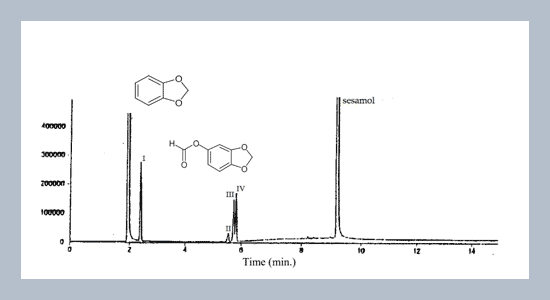Shyh-Shyan Jwo1,2, Ceshing Sheu1*, Dinesh Chandra Agrawal1 1 Department of Applied Chemistry, Chaoyang University of Technology, Taichung, Taiwan (ROC)
2 Sinon Corporation, Ta-Tu Township, Taichung, Taiwan (ROC)
Download Citation:
|
Download PDF
Analysis of impurities in the industrial-grade sesamol (3,4-methylenedioxyphenol, C7H6O3) was carried out. Sesamol, the main antioxidant in sesame oil and the principal chemical intermediate, is used to manufacture paroxetine, an antidepressant drug. Gas chromatography-mass spectrometry (GC-MS) analysis of a sesamol sample indicated the presence of four impurities. After further purification, these four impurities were obtained and characterized by nuclear magnetic resonance (NMR) and Fourier-transform infrared spectroscopy (FTIR). The four sesamol-derived impurities were 1,2-methylenedioxybenzene (C7H6O2), sesamol formate (C8H6O4), sesamol acetate (C9H8O4), and 3,4-methylenedioxybenzaldehyde (C8H6O3). Sesamol and its impurities were assayed by both gas chromatography (GC) and liquid chromatography (LC) for routine quality control. Correlation coefficients (r) in the LC method ranged from 0.9989 to 0.9997, and relative standard deviations (RSD) range from 1.76% to 3.32%. These values were higher than those by the GC method, where correlation coefficients were in the range of 0.9875 to 0.9981 and relative standard deviations in the range of 7.45% to 26.8%. Moreover, the LC method with the limit of detection (LOD) in the range of 0.013 to 0.045 μg/mL was more sensitive than the GC method, where the limit of detection was in the range of 0.067 to 3.103 μg/mL. Therefore, the LC method was more suitable for assay sesamol and its impurities during the in-process control of drug manufacture.ABSTRACT
Keywords:
Impurity analysis, Sesamol, 1,2-methylenedioxybenzene, Sesamol formate, Sesamol acetate, 3,4-methylenedioxybenzaldehyde, Piperonal, Chemical intermediate, Paroxetine.
Share this article with your colleagues
REFERENCES
ARTICLE INFORMATION
Received:
2019-04-12
Revised:
2020-11-28
Accepted:
2020-12-10
Available Online:
2021-03-01
Jwo, S.-S., Sheu, C., Agrawal, D.C. 2021. Identification and quantification of impurities in the industrial-grade sesamol. International Journal of Applied Science and Engineering, 18, 2019053. https://doi.org/10.6703/IJASE.202103_18(1).001
Cite this article:
Copyright The Author(s). This is an open access article distributed under the terms of the Creative Commons Attribution License (CC BY 4.0), which permits unrestricted use, distribution, and reproduction in any medium, provided the original author and source are cited.






